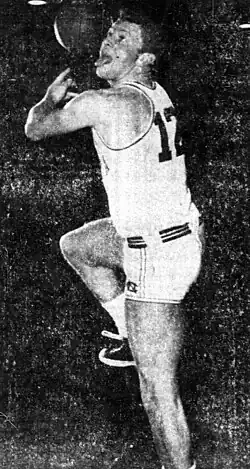Lee Shaffer
 Shaffer, circa 1960 | |
| Personal information | |
|---|---|
| Born | February 23, 1939 Chicago, Illinois, U.S. |
| Listed height | 6 ft 7 in (2.01 m) |
| Listed weight | 220 lb (100 kg) |
| Career information | |
| High school | Baldwin (Pittsburgh, Pennsylvania) |
| College | North Carolina (1957–1960) |
| NBA draft | 1960: 1st round, 5th overall pick |
| Drafted by | Syracuse Nationals |
| Playing career | 1961–1964 |
| Position | Small forward |
| Number | 22 |
| Career history | |
| 1960–1961 | Cleveland Pipers |
| 1961–1964 | Syracuse Nationals / Philadelphia 76ers |
| Career highlights | |
| |
| Career NBA statistics | |
| Points | 3,291 (16.8 ppg) |
| Rebounds | 1,240 (6.3 rpg) |
| Assists | 232 (1.2 apg) |
| Stats at NBA.com | |
| Stats at Basketball Reference | |
Lee Philip Shaffer II (born February 23, 1939) is an American former professional basketball player.
A 6'7" forward born in Chicago, Shaffer starred at the University of North Carolina, where he was the ACC Men's Basketball Player of the Year in 1960.
Shaffer was the #5 selection of the Syracuse Nationals in the 1960 NBA draft, after Naismith Basketball Hall of Fame players Oscar Robertson (#1) and Jerry West (#2). He was selected ahead of future Hall of Famers Lenny Wilkens (#6) and Satch Sanders (#8).
Shaffer and another 1960 First Round Draft choice, Al Bunge (#7), signed with the AAU instead of the NBA, in an era where salaries were small. Shaffer played the 1960–1961 season with the Cleveland Pipers.[1]
He then played three seasons (1961–1964) in the National Basketball Association as a member of the Philadelphia 76ers franchise. An NBA All-Star in 1963, Shaffer held career averages of 16.8 points per game and 6.3 rebounds per game.
NBA career statistics
| GP | Games played | GS | Games started | MPG | Minutes per game |
| FG% | Field goal percentage | 3P% | 3-point field goal percentage | FT% | Free throw percentage |
| RPG | Rebounds per game | APG | Assists per game | SPG | Steals per game |
| BPG | Blocks per game | PPG | Points per game | Bold | Career high |
Regular season
| Year | Team | GP | MPG | FG% | FT% | RPG | APG | PPG |
|---|---|---|---|---|---|---|---|---|
| 1961–62 | Syracuse | 75 | 27.8 | .436 | .771 | 6.8 | 1.3 | 16.9 |
| 1962–63 | Syracuse | 80 | 29.9 | .429 | .784 | 6.6 | 1.2 | 18.6 |
| 1963–64 | Philadelphia | 41 | 24.7 | .370 | .767 | 5.0 | .9 | 13.1 |
| Career | 196 | 28.0 | .420 | .776 | 6.3 | 1.2 | 16.8 | |
Playoffs
| Year | Team | GP | MPG | FG% | FT% | RPG | APG | PPG |
|---|---|---|---|---|---|---|---|---|
| 1962 | Syracuse | 5 | 34.8 | .354 | .774 | 11.0 | 1.4 | 18.8 |
| 1963 | Syracuse | 5 | 34.6 | .479 | .800 | 4.6 | 1.2 | 27.2 |
| 1964 | Philadelphia | 3 | 13.3 | .364 | .500 | 1.3 | .7 | 5.7 |
| Career | 13 | 29.8 | .416 | .778 | 6.3 | 1.2 | 19.0 | |
References
- ^ Bradley, Robert D. (May 2, 2013). The Basketball Draft Fact Book: A History of Professional Basketball's College Drafts. ISBN 9780810890695.